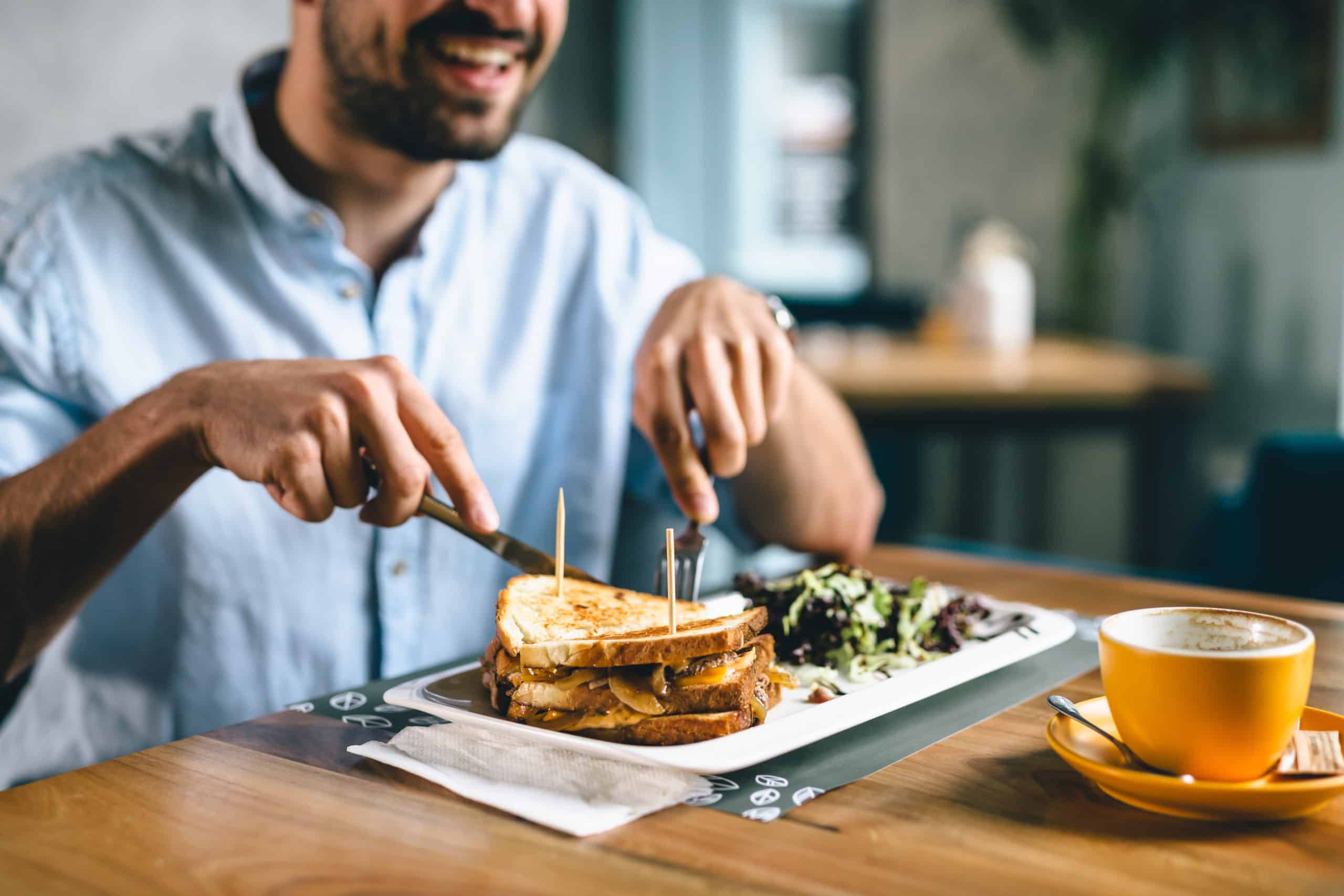What you’ll learn:
- Black coffee is a nearly calorie-free option, but adding creamers, sweeteners, and syrups can quickly turn it into a high-calorie drink.
- Trendy coffee drinks bring unique flavors but may also come with extra calories or unproven health claims.
- Simple changes, like switching to lower-calorie milk or sugar substitutes, can help align your coffee habit with your health goals.
- With Noom, you can explore lighter alternatives and build mindful routines to enjoy coffee without compromising your wellness journey.
Your daily coffee could have a bigger impact on your day than you realize. On average, an 8-ounce black coffee has just two calories, but the same isn’t true about those tempting coffee shop creations. Caffeinated drinks can pack 150-400+ calories, which turns a quick-pick-me-up into a high-calorie treat.
And your homebrew could have more calories than you think, too. The calories from milk, creamer, sugar, and other additions can add up. Knowing what’s going into your cup is key to balancing your love for coffee with your health goals. In this article, we’ll break down the calorie content of your favorite coffee drinks and share tips to enjoy your coffee without adding a ton of calories.
With Noom, it’s easier than ever to track your coffee habits, gain insights into your choices, and build sustainable, mindful routines that fit your lifestyle. Read on to learn how to make every sip count!
How many calories are in black coffee
If you’re a coffee lover trying to manage your calorie intake, you’re in luck if you love black coffee. At its most basic, coffee is practically calorie-free, making it an excellent choice for your morning pick-me-up or afternoon boost. Here’s a look at the nutrition stats:
One cup (8 ounces) of brewed black coffee contains:
- Calories: 2
- Protein: 0.3 grams
- Fat: 0 grams
- Carbohydrates: 0 grams
- Fiber: 0 grams
Coffee also contains antioxidants—nutrients that help prevent and reverse cell damage. Caffeine, the star ingredient, can also increase alertness and give you energy.
Black coffee is also a zero-carb beverage, making it an excellent fit for many eating plans, from low-carb to keto.
Enjoy your coffee with minimal sugar and low-fat creamers to keep calories in check. While black coffee is nearly calorie-free, the story changes once you add other ingredients. Each teaspoon of sugar and splash of half-and-half adds calories to your beverage. These seemingly small additions can quickly add up. And when it comes to fancy coffee house creations, you really have to tread carefully since some can have as many calories as a meal.
*Recommended dietary allowance (RDA) is defined as the average daily amount of nutrients that are needed to meet the requirements of nearly all healthy people in a specific group.
Real results with a personalized weight loss program
Take the quiz!

How popular coffee additions impact the calorie count
There’s nothing wrong with adding sweeteners and creamers; just measure the amount you add to each cup if you’re watching the calorie count. Here are some common additions:
Milk and creamers (per 2 tablespoons)
- Nonfat milk: 10 calories
- Whole milk: 20 calories
- Half-and-half: 40 calories
- Coffee creamer: 70 calories
- Whipped cream: 15 calories
Remember, these amounts are for measured tablespoons; if you free-pour milk or half-and-half, you might add significantly more.
Sugar and sweeteners (per teaspoon)
- Sugar: 16 calories
- Honey: 21 calories
- Maple syrup: 17 calories
- Stevia: 0 calories per packet
- Monk fruit sweetener: 0 calories
- Agave syrup: 21 calories
Again, adding sugar or sweetener without measuring it can significantly change the amount, so be sure to measure if you want to reduce calories.
Calories in popular coffee drinks
Understanding what’s in your favorite coffee drinks can help you make choices that align with your health goals. Use Noom’s Food Lookup tool to find the calories in your go-to coffee and log them. Bonus: The tool will suggest a flavorful alternative if your drink falls in the orange category or the calorie-dense group. Noom’s color system categorizes foods into green, yellow, and orange based on calorie density and nutrient content, helping you make balanced choices while enjoying a variety of foods.
Here are ways to lighten up popular 16-ounce coffee drinks:
| Coffee drink | Approximate calories (16 oz) | How to reduce calories |
|---|---|---|
| Regular coffee (2 tbsp half and half and sugar) | 140 cal | Use zero- or low-calorie sweeteners (such as stevia or monk fruit) instead of sugar and switch to a non-dairy creamer to save 50 – 100 caloriesReplace cream with non-fat milk to reduce 40-60 calories |
| Cappuccino (2% milk) | 120 cal | Try a smaller size—a 12-ounce size has 90 calories.Use low-fat or nonfat milk to save 40 caloriesUse low-fat, plant-based milk alternatives to save around 20 calories |
| Latte (2% milk) | 130 cal | Try a smaller size—there’s 97 calories in a 12-ounce sizeUse low-fat or nonfat milk to save 20 caloriesUse low-fat, plant-based milk alternatives to cut 20 calories |
| Mocha latte (2% milk and whipped cream) | 400+ cal | Get a smaller sizeAsk for nonfat milk or dairy-free alternatives to cut around 50 caloriesUse sugar-free chocolate syrup or reduce the amount to save about 120 caloriesSkip the whipped cream to save 15 – 30 calories |
| Frappuccino/blended coffee | 400+ cal | Choose a smaller sizeRequest fewer pumps of syrup (each pump adds 20 calories)Skip the whipped cream (every serving adds 15 – 30 calories)Ask for nonfat milk or dairy-free alternatives to save 100 – 200 calories |
Remember, being aware of these options doesn’t mean you have to give up your favorites. It’s about making informed choices that work for you and your health journey.
Cold brew vs. hot coffee: Does cold brew coffee have fewer calories?
Cold brew is created by steeping coffee grounds in cold water for 12 to 24 hours, resulting in a smoother, less acidic taste than traditional hot-brewed coffee. This gentle extraction process creates coffee that many find easier on their stomachs. Despite these differences, they contain roughly the same calories: about two per eight ounces.
What really makes a difference between the two? The size ordered, the type of milk chosen, and any sweeteners or syrups added.
Let’s break down a typical cold brew order:
- Base cold brew (16 oz): 4 calories
- Sweet cream cold foam (1/4 cup): 35-80 calories
- Flavored syrup (1 pump): 20-30 calories
- Caramel drizzle (1 serving/15g): 15 calories
That refreshing cold brew can pack an extra 70 to 125 calories—before considering specialty versions that might include additional bits of cookies, chocolate, and other sweet additions.
In general, cold brews have smoother tastes, which means they might need less sweetener than hot coffee to be enjoyable. Start with less sweetener than you need—you might enjoy the natural flavors more than expected.
Cold brew vs. hot coffee: Caffeine content
Cold brew typically has more caffeine than regular brewed coffee, but the exact amount depends on a few factors:
- Brewing process: The extended brewing process for cold brew extracts more caffeine from the coffee grounds than the shorter brewing process for hot coffee.
- Coffee-to-water ratio: Cold brew uses a higher coffee-to-water ratio than regular coffee, increasing its caffeine content.
How much coffee is too much coffee?
Black coffee offers some health benefits from the antioxidants, but drinking too much of the caffeinated variety can cause issues. While individual tolerance to caffeine varies, these general guidelines can help you determine how much is too much.
The FDA says that up to 400 milligrams of caffeine daily is safe for most healthy adults. This amount is roughly equivalent to:
- Four 8-ounce cups of black coffee (regular)
- Check the size of your favorite mug or to-go cup. Many people have insulated mugs that hold 16-32 ounces.
- Six 1-ounce shots of espresso
- Note: Many coffee house drinks have 2 to 3 shots of espresso per drink.
- Two 16-ounce cups of iced coffee or cold brew
- People tend to drink cold coffee in larger amounts.
Does coffee affect hunger and cravings?
Your morning coffee does more than just wake you up—it might also influence your hunger. However, relying on coffee as a tool to curb hunger isn’t recommended, as it may interfere with recognizing and responding to your body’s natural hunger cues. Here’s what you need to know:
- Curb hunger pangs: Coffee may temporarily reduce appetite and how much you eat. Research shows that having coffee 30 minutes to four hours before a meal may help you eat less. However, using it to suppress hunger regularly can lead to imbalanced eating habits or prevent you from getting the nutrients you need.
- Feel fuller for longer: Coffee may increase feelings of satisfaction after eating. Some studies suggest caffeine could delay the return of hunger, but this effect varies and is not a substitute for nourishing meals.
- Beware the sugar rollercoaster: While black coffee may tame your appetite, sugary coffee drinks can have the opposite effect. The quick energy spike from added sugars often leads to a crash, leaving you craving more snacks later.
- Team up with meals: Instead of using coffee to replace food, pair it with a balanced meal or snack to keep your energy steady and hunger in check. Noom’s food color system can help you choose nutrient-dense, satisfying options to pair with your coffee that align with your goals.
Master your coffee choices with Noom
Your favorite coffee drink doesn’t have to clash with your health goals. Whether you’re a fan of basic coffee with cream and sugar or love cold brew topped with sweetened cold foam, small adjustments can make a big difference. Using non-fat milk, reducing the amount of sweetener, or even opting for a smaller size can make your drink delicious and aligned with your goals.
With Noom, you’ll go beyond simply tracking calories. Noom’s personalized tools and lessons help you understand how your choices, like that what’s in your morning coffee cup, fit into your broader health journey. It’s not about restriction; it’s about building sustainable habits that suit your lifestyle.
Complete our quick questionnaire today and see how Noom can help you turn your coffee habit into a healthier, balanced part of your day!




